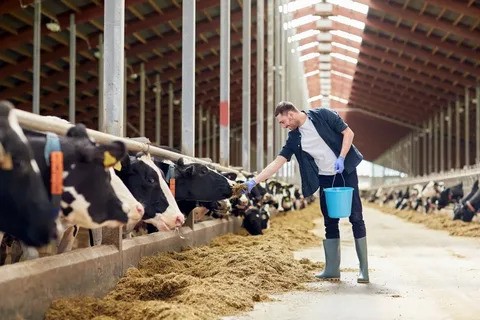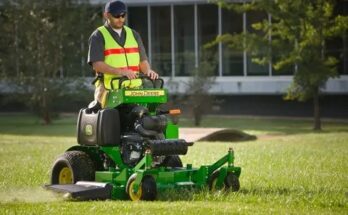U.S. Dairy Farm Jobs
The U.S. dairy industry is a cornerstone of American agriculture, producing over 226 billion pounds of milk annually and supporting nearly 3 million jobs. From the rolling pastures of Wisconsin to the mega-dairies of California, dairy farming is more than a job—it’s a way of life that blends tradition with cutting-edge technology. Despite challenges like labor shortages, price volatility, and environmental pressures, the sector remains vital to rural economies and global food security. For workers seeking stable careers, immigrants pursuing the American Dream, or urbanites craving a rural reset, dairy farm jobs offer opportunities to grow, innovate, and contribute to a sustainable future.
This guide explores the landscape of U.S. dairy farm jobs, including roles, regional demand, training requirements, immigration pathways, and the industry’s evolving priorities.
Why Dairy Farming Matters in the U.S.
- Economic Powerhouse:
- The dairy industry contributes $75 billion annually to the U.S. economy.
- Top-producing states include California (18% of U.S. milk), Wisconsin, Idaho, Texas, and New York.
- Global Leadership:
- The U.S. is the world’s second-largest milk producer (after India) and a leading exporter of cheese, whey, and butter.
- Labor Shortages:
- Over 55,000 dairy jobs go unfilled yearly, driven by an aging workforce and declining rural populations.
- Technological Innovation:
- Robotics, AI herd management, and methane-reduction tech are reshaping dairy farms.
- Immigrant Workforce:
- Immigrants fill 50–80% of dairy jobs, often through visas like H-2A or undocumented pathways.
Types of Dairy Farm Jobs
1. Entry-Level Roles
- Milking Technicians: Operate milking parlors or robotic systems.
- Average Pay: 13–20/hour.
- Feeding Crew: Prepare and distribute feed to herds.
- Calf Caretakers: Manage newborn calves’ health and nutrition.
2. Skilled Trades
- Herdsmen: Oversee cow health, breeding, and birthing.
- Average Pay: 40,000–60,000/year.
- Equipment Operators: Handle tractors, manure spreaders, and feed mixers.
- Certifications: CDL (Commercial Driver’s License) often required.
3. Management and Technical Roles
- Dairy Farm Managers: Supervise daily operations, budgets, and staff.
- Average Pay: 60,000–90,000/year.
- Nutritionists: Formulate feed plans to optimize milk production.
- Veterinary Assistants: Support animal health under a vet’s guidance.
4. Sustainability and Tech Roles
- Management Specialists: Implement waste-to-energy systems (e.g., biogas digesters).
- Robotics Technicians: Maintain automated milking and feeding systems.
Regional Hotspots for Dairy Jobs
1. Midwest (Wisconsin, Minnesota, Michigan)
- Wisconsin: “America’s Dairyland” has 1.2 million cows and 6,000 farms.
- Key Employers: Foremost Farms, Schreiber Foods.
- Average Pay: 15–22/hour.
- Trend: Artisan cheesemaking and organic farms.
2. West (California, Idaho, Washington)
- California: Leads in milk production with 1,700 large-scale dairies.
- Automation: 30% of farms use robotic milkers.
- Average Pay: 16–24/hour.
- Idaho: Rapid growth in cheese processing (e.g., Chobani).
3. Northeast (New York, Pennsylvania, Vermont)
- New York: 4,000 dairy farms supply NYC markets.
- Trend: Grass-fed and regenerative dairy.
- Vermont: Home to Ben & Jerry’s and Cabot Creamery.
4. South (Texas, Florida)
- Texas: Expanding mega-dairies in the Panhandle.
- Challenges: Heat stress management for cows.
How to Start a Dairy Farming Career
1. Education and Certifications
- High School Diploma: Required for most roles; animal science courses are a plus.
- Associate Degrees: Dairy management programs (e.g., SUNY Cobleskill, UW-Madison).
- Certifications:
- National FARM Program: Training in animal care and sustainability.
- AI/Breeding Certifications: Offered by organizations like Select Sires.
2. Gain Experience
- Apprenticeships: State programs (e.g., Wisconsin’s Dairy Grazing Apprenticeship).
- Internships: Universities and cooperatives like Land O’Lakes.
3. Immigration Pathways
- H-2A Visa: Seasonal agricultural workers (limited for year-round dairy roles).
- TN Visa: Canadian/Mexican citizens in managerial/technical roles (NAFTA).
- State-Sponsored Programs: NY’s “Milk for Refugees” initiative trains immigrants.
4. Apply Directly
- Job Boards: DairyHerd, AgCareers.com, local co-op listings.
- Networking: Attend dairy expos like World Dairy Expo (Madison, WI).
Challenges in Dairy Farming
- Physical Demands: Long hours, extreme weather, and repetitive tasks.
- Price Volatility: Milk prices fluctuate due to global markets and policy changes.
- Environmental Regulations: Managing manure runoff and methane emissions.
- Immigration Uncertainty: Reliance on undocumented workers amid shifting policies.
The Future of Dairy Jobs
- Automation:
- Robotic milkers (DeLaval, Lely) reduce labor needs but require tech-savvy workers.
- Drone monitoring of pasture health.
- Sustainability Initiatives:
- Net-zero goals by 2050 (Innovation Center for U.S. Dairy).
- Carbon credit programs for methane digesters.
- Niche Markets:
- A2 milk, organic, and plant-based dairy alternatives.
- Agritourism roles (farm stays, cheese tastings).
- Workforce Development:
- Dairy Grazing Apprenticeships and youth programs (FFA, 4-H).
- Spanish-language training for immigrant workers.
Why Choose a Dairy Career?
- Stability: Essential industry with consistent demand.
- Rural Lifestyle: Work in tight-knit communities with access to land.
- Advancement: Grow from laborer to farm owner or agribusiness leader.
- Impact: Sustain a 400-year tradition while pioneering eco-friendly practices.
U.S. Dairy Farm Jobs
Dairy farm jobs in the U.S. offer more than a paycheck—they’re a chance to steward the land, care for animals, and sustain a legacy that feeds millions. Whether you’re milking cows in Wisconsin, managing a robotic parlor in California, or engineering sustainable solutions in Vermont, this sector blends hard work with heart. Despite challenges, technological advances and a growing focus on sustainability are milking new opportunities for those ready to embrace this vital industry.
Milk the Moment. Build a Legacy.
FAQ Section
- Do I need experience to work on a dairy farm?
Entry-level roles often require no prior experience, but animal handling skills are a plus. - Are visas available for foreign dairy workers?
H-2A visas cover seasonal work, but year-round dairy roles face legal hurdles. Some states offer ad-hoc solutions. - Is dairy farming physically demanding?
Yes—expect early mornings, heavy lifting, and outdoor work in all weather. - Can I transition to farm ownership?
Yes! Programs like USDA’s Beginning Farmer Loans help launch first-gen farmers. - How is automation affecting jobs?
Robotics reduce manual labor but create tech maintenance and data analysis roles.



